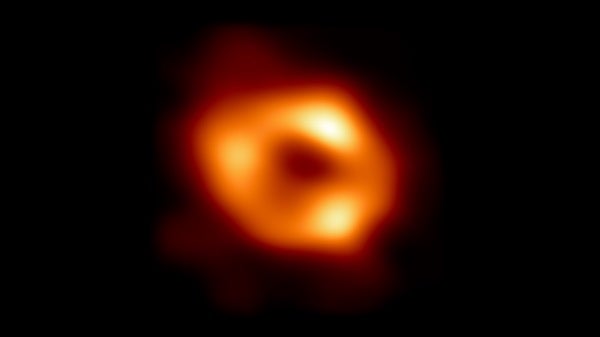Editor’s note: An additional clarification has been edited in from the author in response to a follow-up question post-publication.
How far from Earth would a telescope have to be to capture a direct view of the black hole at the center of the Milky Way, unimpeded by dust clouds?
At the center of our galaxy sits a supermassive black hole known as Sagittarius A*, or Sgr A* for short. This black hole was first discovered in 1974 as a pointlike radio source. Sgr A* cannot be viewed with an optical telescope because, as you point out, interstellar dust and gas clouds in the plane of the Milky Way obscure any radiation coming from the center of the galaxy.
This dense ring of molecular gas orbits with 10 to 20 light-years of Sgr A*. So, if one was within this distance to the black hole, Sgr A* should be observable.
Alternatively, the orientation of the ring is roughly along the plane of the galaxy. Therefore, if Sgr A* is observed at an angle away from the disk of the galaxy, someone should be able to see the center of the galaxy in visible light.
But there is currently no realistic way for us to get an optical telescope close enough to Sgr A* that the dust and gas would not be a problem. Remember, the farthest human-made objects are the Voyager spacecrafts, which launched in 1977 — neither of which have definitively passed outside the solar system at the time of writing.
If we were in contact with an advanced alien civilization near the center of the galaxy, theoretically they could send us an image. But, in the meantime, researchers have come up with an even better solution: the Event Horizon Telescope (EHT). You’ve probably already seen the news by now: The EHT revealed the first image of Sgr A* earlier this year, on May 12. This was just the second time the world has ever seen a black hole — the first was M87*, three years prior.
The EHT is a global array of 11 telescopes. Instead of optical light, these telescopes can see in radio wavelengths, meaning they can peer past the dust and gas and see the black hole. Or, more accurately, they can see the very bright material swirling into the black hole, known as the accretion disk. The shadow of the black hole’s event horizon — the point of no return, where not even light can escape the object’s gravity — appears silhouetted against the accretion disk.
Because of its proximity and mass (approximately 4 million times that of the Sun), Sgr A* presents an unparalleled opportunity to study how physics behaves under such extreme gravity. It also offers a fantastic opportunity to study how material is captured, accreted, and ejected by a black hole.










